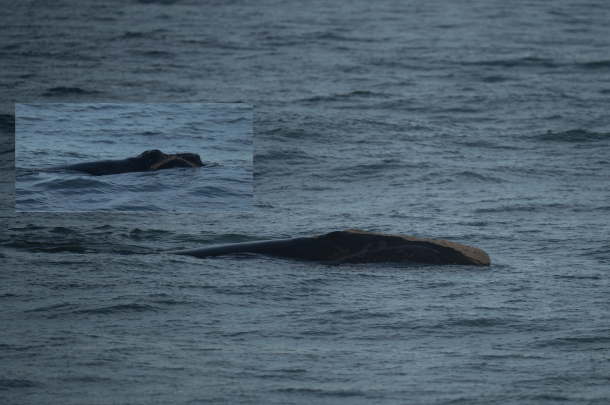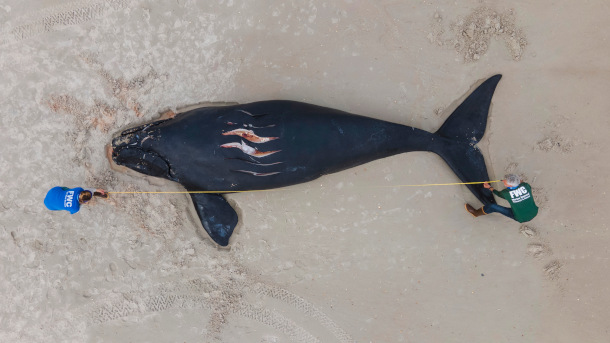Hope From Baby Right Whales
Air Date: Week of February 3, 2023
Spindle, who is more than 41 years old, had her tenth calf this season. Right whale Catalog number 1204 'Spindle' and calf sighted on January 7, 2023, approximately 6nm east of St. Catherines Island, GA. Photo credit: Clearwater Marine Aquarium Research Institute, taken under NOAA permit number 20556.
North Atlantic Right Whales are critically endangered with fewer than 350 individuals left, but the births of several baby whales this season are bringing a glimmer of hope for the species. Living on Earth's Sophia Pandelidis reports that so far this season scientists have observed at least 11 living North Atlantic right whale calves in the warm coastal waters of the southern US.
Transcript
CURWOOD: From PRX and the Jennifer and Ted Stanley studios at the University of Massachusetts Boston, this is Living on Earth. I'm Steve Curwood.
And I'm Bobby Bascomb.
North Atlantic Right Whales are critically endangered with less than 350 individuals remaining. Right whale populations have been in trouble since the 1800s when they were targeted for hunting. They floated to the surface when killed making them easy to recover and giving them their name as they were the "right" whale to hunt.
CURWOOD: Whale hunting was banned in the US in 1971, though there is an exception for registered native Alaskans to hunt bowhead whales. But even with a hunting ban north Atlantic right whales are still vulnerable to ship strikes and entanglement in fishing gear used for lobstering as they live mostly near the surface close to the shore along the East Coast. US government efforts to protect the whales by restricting boating speeds and fishing areas have failed to halt their decline and calls for stricter protections are controversial.
BASCOMB: And right now is a critical time for the whales. November to April is calving season for them. Baby whales are crucial to the survival of the species and are being born in the warm coastal waters of the Southern US. So far this season scientists have observed at least 11 living North Atlantic right whale calves. Living on Earth's Sophia Pandelidis has more.
PANDELIDIS: The eleven babies were spotted off the coast of Florida and Georgia, where the animals migrate to breed. They migrate the entire length of the East Coast from Canada. In early January, another calf was found dead in North Carolina. Scientists are still trying to determine the cause, but as far as we know, eleven remain alive and well. These newborns will stay with their mothers for about a year, and for many scientists, it's a joy to watch these mama whales bring life into the world. Many of them have names and are well known to researchers.

Pilgrim, a ten-year-old North Atlantic right whale, is a first-time mom this year. A composite image of "Pilgrim" (Catalog number 4340) and calf, sighted by beachgoers off Canaveral, FL on December 30. Photo credit: Photo taken from land by Joel Cohen, Marine Resources Council.)
DURETTE-MORIN: I try not to play favorites too much. But I am particularly excited about Pilgrim. It's her first time being a mom. So that's really cool. She's 10 years old.
PANDELIDIS: Delphine Durette-Morin is an Assistant Scientist at the Canadian Whale Institute, and she says that while Pilgrim may be fresh on the parenting scene, other females are veteran moms.
DURETTE-MORIN: Spindle is more than 41 years old. And this is actually her 10th calf, which is pretty amazing.
PANDELIDIS: Although eleven living calves so far is better than the zero calves born in 2018, it's still about half the average observed in recent years. More calves could be born in the second half of the season, but Delphine says the final count is unlikely to keep pace with death and injury. And some scientists argue that a small number of calves could actually recover the population if we just stopped hurting and killing them. The whales are often wounded by rope entanglements and ship strikes, injuries that can drastically reduce a female's ability to carry a calf to term.

Mothers and calves spend most of their time near the ocean's surface, making them more vulnerable to ship strikes. In 2021, a calf hit by a sportfishing boat washed up on the Florida shore. (Photo: FWC/Tucker Joenz, Flickr, NOAA Fisheries permit number 18786)
DURETTE-MORIN: There's only so much energy that an adult female has to allocate to reproduction. And so, if she's allocating that energy to other things like staying alive, let's say she has an entanglement. That's going to take up a lot of her energy and she won't have any left for reproduction.
PANDELIDIS: And sometimes, entanglements and ship strikes are fatal. In 2021, a calf hit by a sportfishing boat washed up on the Florida shore. His mother, Infinity, was never seen again. Scientists like Delphine hope that regulating ship speeds, altering shipping routes, and investing in whale friendly fishing gear will prevent these kinds of deaths. The question is, will we move quickly enough to give them a chance? For Living on Earth, I'm Sophia Pandelidis.
Links
New England Aquarium | "2022-2023 North Atlantic Right Whale Mother and Calf Pairs"
NOAA Fisheries | "2017-2023 North Atlantic Right Whale Unusual Mortality Event"
Regulations.gov | "Proposed Rule: North Atlantic Right Whale Vessel Strike Reduction Rule"
Living on Earth wants to hear from you!
Living on Earth
62 Calef Highway, Suite 212
Lee, NH 03861
Telephone: 617-287-4121
E-mail: comments@loe.org
Newsletter [Click here]
Donate to Living on Earth!
Living on Earth is an independent media program and relies entirely on contributions from listeners and institutions supporting public service. Please donate now to preserve an independent environmental voice.
NewsletterLiving on Earth offers a weekly delivery of the show's rundown to your mailbox. Sign up for our newsletter today!
 Sailors For The Sea: Be the change you want to sea.
Sailors For The Sea: Be the change you want to sea.
 The Grantham Foundation for the Protection of the Environment: Committed to protecting and improving the health of the global environment.
The Grantham Foundation for the Protection of the Environment: Committed to protecting and improving the health of the global environment.
 Contribute to Living on Earth and receive, as our gift to you, an archival print of one of Mark Seth Lender's extraordinary wildlife photographs. Follow the link to see Mark's current collection of photographs.
Contribute to Living on Earth and receive, as our gift to you, an archival print of one of Mark Seth Lender's extraordinary wildlife photographs. Follow the link to see Mark's current collection of photographs.
 Buy a signed copy of Mark Seth Lender's book Smeagull the Seagull & support Living on Earth
Buy a signed copy of Mark Seth Lender's book Smeagull the Seagull & support Living on Earth

